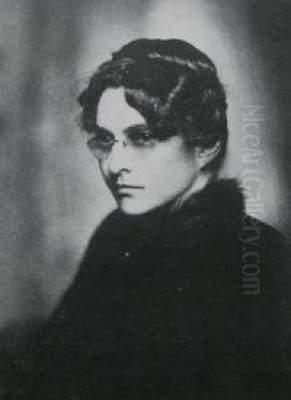
Anna Althea Hills stands as a pivotal figure in the narrative of American Impressionism, particularly within the vibrant artistic landscape of early twentieth-century California. Born on January 28, 1882, in Ravenna, Ohio, and passing away far too young on June 13, 1930, in Laguna Beach, California, Hills forged a remarkable career not only as a gifted painter of light-filled landscapes but also as a dedicated educator and a foundational community leader. Her legacy is intrinsically tied to the development of the Laguna Beach art colony and the broader California Impressionist movement, showcasing a profound connection to the natural beauty of her adopted state and an unwavering commitment to fostering its artistic culture.
Early Life and Artistic Formation
Anna Hills's early life was marked by change and resilience. Her father, a Presbyterian minister, led the family through several relocations during her childhood. A significant personal trial occurred when Anna was just four years old; her mother passed away, leading to her upbringing by her maternal grandmother, Althea Alamora Ford. This early exposure to adaptation and the strong presence of her grandmother likely shaped the determination and community spirit that would define her later years. Even in these formative times, her inclination towards art began to surface.
Her formal artistic training commenced at Olivet College in Michigan. Seeking more rigorous instruction, she then moved on to the prestigious Art Institute of Chicago, followed by studies at the Cooper Union for the Advancement of Science and Art in New York City. These institutions provided her with a solid foundation in academic drawing and painting techniques, exposing her to the prevailing artistic currents of the American art world at the turn of the century. However, like many ambitious American artists of her generation, Hills felt the pull of Europe, the epicenter of artistic innovation.
European Sojourn and Influential Mentors
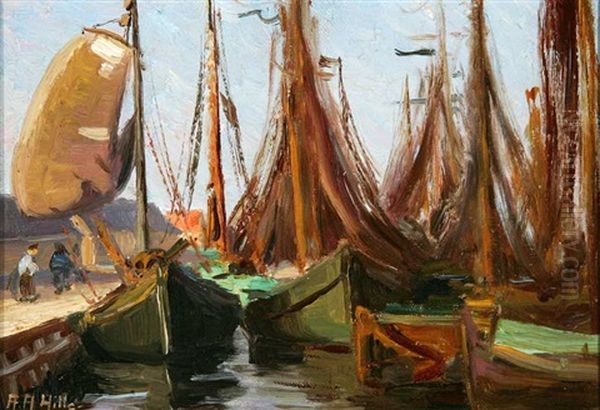
Hills traveled to Europe to further refine her skills and broaden her artistic horizons. She enrolled in the renowned Académie Julian in Paris, a progressive institution known for accepting female students at a time when the official École des Beaux-Arts did not. In Paris and during her time studying in England, she absorbed the influences of European art movements, particularly Impressionism and Post-Impressionism, which were still reverberating through the continent's art scene.
Crucially, during her studies, she came under the tutelage of several influential figures. One key mentor was Arthur Wesley Dow, an innovative American painter, printmaker, photographer, and influential arts educator. Dow, known for his teaching at Pratt Institute and later Columbia University Teachers College, emphasized principles of composition, design, and the harmonious arrangement of line, mass, and color, drawing heavily from Japanese aesthetics (Japonisme). His structured approach, focusing on subjective expression through design rather than strict academic realism, left a lasting imprint on Hills's understanding of picture-making.
Another significant teacher was John Noble Barlow, an American-born painter who achieved considerable success in England and was known for his atmospheric landscape paintings, often depicting the countryside of Cornwall near St Ives, a burgeoning art colony. Barlow, a member of the Royal Institute of Oil Painters (ROI) and the Royal Society of British Artists (RBA), likely reinforced Hills's interest in landscape painting and possibly introduced her to the techniques of capturing the nuances of natural light and weather, perhaps influencing her later plein air practices. Studying with Barlow in England exposed her to the British landscape tradition as well.
During her European period, Hills's work often reflected the prevailing tastes, sometimes featuring interior scenes or figurative works rendered with a relatively darker, more tonal palette compared to her later California output. Some accounts suggest an influence from the Dutch handling of light, particularly evident in works depicting scenes from Holland, such as her later painting Drying Nets, Huizen, Holland. This period was essential for technical development and absorbing international trends before she found her unique voice under the California sun.
The Lure of the West: Relocation to California
Around 1912 or 1913, Anna Althea Hills made the life-altering decision to move across the country to Southern California. She settled in the burgeoning coastal town of Laguna Beach, a location that was rapidly gaining a reputation as an idyllic haven for artists. The region offered a unique combination of stunning natural beauty – dramatic coastlines, rolling hills, canyons, nearby mountains, and deserts – bathed in a quality of light that was particularly attractive to painters interested in Impressionist principles.
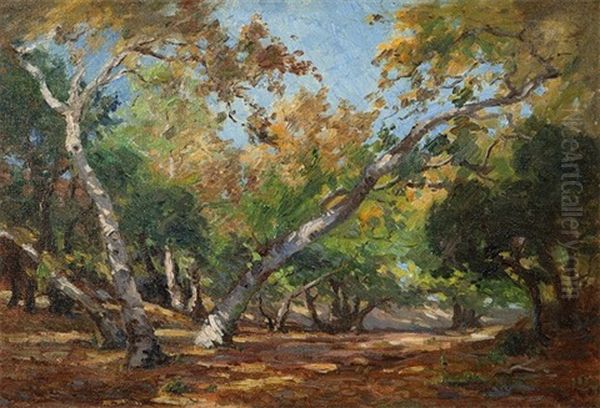
The move marked a profound turning point in Hills's artistic trajectory. The intense sunlight, vibrant colors, and diverse landscapes of Southern California provided a stark contrast to the environments she had previously known and painted. This new setting catalyzed a significant transformation in her style, pushing her away from the darker palettes and interior subjects towards the bright, airy, and colorful approach that would define her mature work and align her with the burgeoning California Impressionist movement.
California Impressionism: A New Palette, A New Vision
Upon settling in California, Hills fully embraced the tenets of Impressionism as adapted by artists working under the unique conditions of the American West. Her artistic style underwent a dramatic shift. The somber tones of her earlier work gave way to a high-key palette filled with luminous blues, greens, ochres, and lavenders, reflecting the brilliant sunshine and clear atmosphere of the region. Her brushwork became bolder and more expressive, often applied in distinct, broken strokes that captured the shimmering effects of light on surfaces.
Hills became a dedicated plein air painter, working directly outdoors to capture the fleeting moments of light and color in the landscape. Her subjects were the diverse natural environments surrounding her: the rugged coastline of Laguna Beach with its cliffs and crashing waves, the tranquil beauty of inland canyons dotted with eucalyptus and sycamore trees, the rolling hills characteristic of the region, and the stark, dramatic landscapes of the nearby deserts in California and Arizona. She possessed a remarkable ability to convey the specific atmosphere and unique character of these varied locales.
Her work is often compared to that of other leading California Impressionists, though she maintained her distinct artistic personality. Like William Wendt, often called the "Dean of Southern California landscape painters," she depicted the structure and grandeur of the land, but perhaps with a lighter touch. Similar to Edgar Payne, known for his powerful Sierra Nevada mountain scenes and vibrant seascapes, Hills tackled diverse terrains, though her coastal scenes often focused on the specific light and color of the Laguna area. She shared an interest in capturing the unique flora with artists like Granville Redmond, famous for his paintings of California poppies, though Hills's focus remained broader. Her adept handling of light and color places her firmly within the core group of artists who defined California Impressionism, including figures like Guy Rose, Franz Bischoff, and Maurice Braun.
Laguna Beach: Building an Art Community
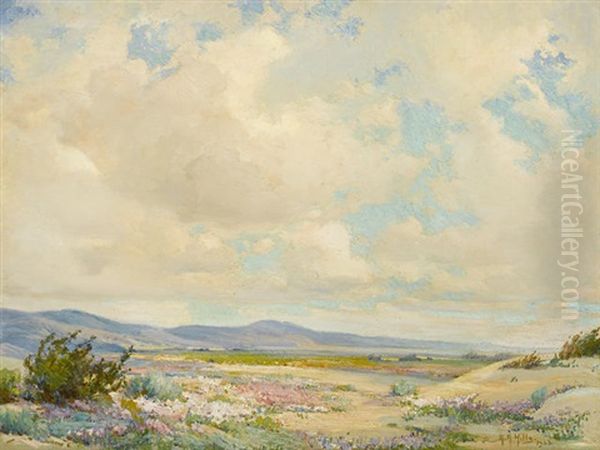
Anna Althea Hills arrived in Laguna Beach just as it was solidifying its identity as an art colony. Artists were drawn not only by the scenery but also by the potential for a supportive community. Hills quickly became a central figure in this burgeoning scene, demonstrating exceptional leadership qualities alongside her artistic pursuits.
Recognizing the need for a formal organization and exhibition space, Hills played an instrumental role in the founding of the Laguna Beach Art Association (LBAA) in August 1918. She was one of the driving forces behind its establishment, working alongside other prominent artists like Edgar Payne, who served as the LBAA's first president, and likely collaborating with figures such as William Wendt and others who formed the core of the early colony. Before the LBAA's formal gallery was built, Hills and her sister, Nellie Fowle Hills, reportedly operated one of the first dedicated art galleries in Laguna Beach out of their cottage, providing an early venue for local artists.
Hills's commitment to the LBAA was profound. She served as its president for six crucial years, in two separate terms (1922–1925 and 1927–1930), guiding the organization through periods of significant growth and development. During her leadership, she spearheaded fundraising efforts, most notably the campaign to build a permanent, custom-designed gallery. This gallery, opened in 1929, became the heart of the art colony and eventually evolved into the Laguna Art Museum, a testament to the vision and dedication of Hills and her contemporaries. Her energy, enthusiasm, and organizational skills were widely acknowledged as vital to the LBAA's success and the establishment of Laguna Beach as a lasting center for the arts.
Representative Works and Artistic Themes
Anna Althea Hills's body of work showcases her mastery of the Impressionist style and her deep connection to the landscapes she painted. While a comprehensive catalogue is challenging, several works are often cited as representative of her style and thematic concerns.
Drying Nets, Huizen, Holland (c. early 1920s), though depicting a European scene likely based on earlier sketches or studies, demonstrates her skill in composition and capturing atmospheric light, possibly reflecting the lingering influence of her European training and Dutch art. It serves as an interesting comparison point to her brighter California works.
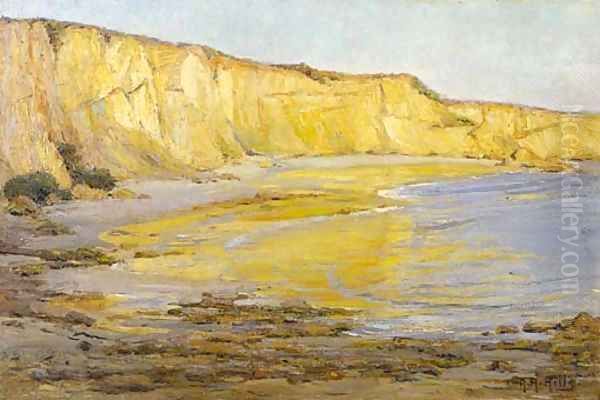
Her California landscapes are where her mature style truly shines. Threatening Storm, Palm Springs captures the dramatic mood and unique light of the desert environment, showcasing her ability to render atmospheric effects and the stark beauty of the arid landscape. The title itself suggests a narrative element, a moment of tension in nature that appealed to her artistic sensibility.
Summer in the Canyon exemplifies her treatment of the local Laguna scenery. Such works typically feature vibrant greens and golds, the dappled sunlight filtering through trees like eucalyptus or sycamores, and a sense of warmth and tranquility. These paintings celebrate the intimate beauty of the coastal canyons, a recurring subject for many Laguna artists.
Beyond specific titles, her oeuvre is characterized by recurring themes: the dynamic interplay of light and shadow on the Pacific Ocean, the rugged cliffs and hidden coves of the Laguna coastline, the golden and purple hues of the surrounding hills, particularly at dawn or dusk, and the expansive vistas of the Southern California deserts. She worked proficiently in both oil and watercolor, adapting her technique to the medium while consistently pursuing the Impressionist goal of capturing the immediate sensory experience of nature. Her works often convey a sense of reverence and joy in the face of natural beauty, reflecting a deeply felt connection to her environment.
Educator and Mentor: Nurturing Future Talent
Beyond her own painting and her leadership within the LBAA, Anna Althea Hills was a respected and influential art teacher. She believed strongly in the importance of arts education and actively worked to nurture the talents of others within the Laguna Beach community and beyond. She taught painting classes, likely incorporating principles learned from her own mentors like Arthur Wesley Dow, emphasizing design and personal expression alongside technical skill.
Her impact as an educator is evidenced by the success of artists she guided. One notable example is George Kennedy Brandriff (1890-1936), a talented painter known for his vigorous seascapes and landscapes, whom Hills mentored and supported early in his career. Her encouragement and guidance helped shape the development of several artists within the Laguna Beach sphere, contributing to the continuation of the region's artistic tradition.
Her teaching activities extended beyond formal classes. Through her leadership at the LBAA, she helped create opportunities for artists to exhibit and learn from one another. She championed the idea of art as an integral part of community life, advocating for art education in local schools and organizing events that brought art to the public. Her role as an educator was thus intertwined with her community building efforts, reflecting a holistic commitment to the cultural enrichment of Laguna Beach.
Overcoming Adversity: A Resilient Spirit
Anna Althea Hills's life and career are made even more remarkable by the fact that she contended with significant physical challenges. She suffered from a chronic and severe spinal ailment, reportedly the result of an injury, which caused her considerable pain and physical limitations. Despite this debilitating condition, Hills possessed an adventurous spirit and an unwavering dedication to her art that refused to be constrained.
She was known to undertake arduous journeys into remote and rugged areas to paint en plein air. She explored the mountains and deserts of Southern California and Arizona, seeking out dramatic landscapes far from the comforts of town. This determination to capture the untamed beauty of the West, even at considerable personal cost, speaks volumes about her passion and resilience. Her ability to maintain an active painting career, fulfill demanding leadership roles at the LBAA, and engage in teaching, all while managing chronic pain, earned her immense respect and admiration from her peers and the community. This inner strength undoubtedly fueled both her artistic output and her tireless community service.
Recognition and Affiliations
Throughout her career, Anna Althea Hills achieved significant recognition for her work and was an active member of several prestigious art organizations. Her paintings were frequently included in major regional and national exhibitions, contributing to the growing reputation of California art.
A notable early success was winning a Bronze Medal at the Panama-California Exposition held in San Diego in 1915-1916. This major event was crucial for showcasing the talents of California artists to a wider audience. Her participation and award underscored her standing among the leading painters of the region.
She was an active and early member of the influential California Art Club (CAC), headquartered in Los Angeles but with strong ties to the Laguna Beach colony. The CAC played a vital role in promoting Impressionism in Southern California, and Hills exhibited regularly in its annual shows alongside fellow members like William Wendt, Edgar Payne, Benjamin Brown, Hanson Puthuff, Marion Kavanagh Wachtel, Elmer Wachtel, and Donna Schuster. Her involvement with the CAC connected her to the broader Southern California art scene.
Reflecting her proficiency in watercolor, she was also a member of the Washington Watercolor Club, indicating her engagement with art circles beyond California. Her primary affiliation, however, remained the Laguna Beach Art Association, the organization she poured so much of her energy into building. Her works were regularly featured in LBAA exhibitions held at their gallery (later the Laguna Art Museum) and at venues like the Los Angeles County Museum of History, Science and Art (a precursor to LACMA).
Enduring Legacy
Anna Althea Hills passed away on June 13, 1930, at the relatively young age of 48, while still actively leading the Laguna Beach Art Association. Her death was a significant loss to the California art community. Her legacy, however, endures through multiple avenues: her captivating body of work, her foundational role in establishing one of California's most enduring art institutions, and her influence as an educator and community leader.
Her paintings are held in the collections of major museums, including the Laguna Art Museum, The Irvine Museum Collection at the University of California, Irvine, and other institutions specializing in California art, as well as in numerous private collections. They continue to be admired for their vibrant color, dynamic compositions, and evocative portrayal of the Southern California landscape during a key period of its artistic development. She is consistently recognized as one of the most important women artists within the California Impressionist movement, alongside figures like Marion Kavanagh Wachtel and the sculptor Julia Bracken Wendt.
The Laguna Art Museum stands today as a direct result of the efforts of Hills and her fellow LBAA pioneers. A bronze plaque within the museum commemorates her vital contributions, ensuring that her role as a driving force behind the institution is remembered. More broadly, her tireless work helped solidify Laguna Beach's identity as an art colony, a legacy that continues to shape the town's cultural character.
Conclusion
Anna Althea Hills was more than just a painter of beautiful landscapes; she was a visionary force who profoundly shaped the artistic landscape of Southern California. Her journey from Ohio through the art centers of America and Europe culminated in a deep and expressive connection with the light and land of California. Her Impressionist paintings capture the unique beauty of the region with vibrancy and sensitivity. Equally important was her unwavering dedication to building a supportive community for artists through her leadership at the Laguna Beach Art Association and her commitment to education. Facing personal adversity with remarkable resilience, Anna Althea Hills left behind a dual legacy: a collection of luminous artworks and a thriving arts institution, cementing her place as a key figure in American art history.